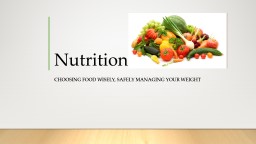

Why you Eat Reasons for eating To meet your nutritional needs To satisfy your appetite To supply your body with energy Hunger feeling of physical discomfort that is caused by your bodys need for nutrients inborn response ID: 1025863
Download Presentation The PPT/PDF document "Nutrition Choosing food wisely, Safely m..." is the property of its rightful owner. Permission is granted to download and print the materials on this web site for personal, non-commercial use only, and to display it on your personal computer provided you do not modify the materials and that you retain all copyright notices contained in the materials. By downloading content from our website, you accept the terms of this agreement.
1. NutritionChoosing food wisely, Safely managing your weight
2. Why you EatReasons for eating:To meet your nutritional needsTo satisfy your appetiteTo supply your body with energyHunger- feeling of physical discomfort that is caused by your body’s need for nutrients, inborn responseAppetite- desire for food that is based on emotions and other factors rather than nutritional need, learned responseEat because smell, causes eating when not hungry
3. Basal Metabolic Rate(BMR)The rate at which you use energy when your body is at restAffects your caloric needsHigher BRM=more calories burnedFactors- age(young=higher), muscle mass(more=higher), activity level(high=higher)
4.
5. The Foods You ChoosePersonal preferences- what you like, what tastes good to youCultural background- what we are accustomed toTime and convenience- busy scheduleFriends- influence new foodsMedia- ads, commercials
6. Evaluating Food ChoicesImportant to read and evaluate food labels.Food labels- FDA requires manufacturers to include food label on most prepared foods.Must list specific nutrition facts including calorie and nutrient content, ingredientsUsually printed on back or side of packageNutrients and health claims- standards set by FDA that can be printed on package
7.
8. Evaluating Food Choices(cont.) Daily values- recommendations that specify the amount of certain nutrients that the average person should obtain daily.General guideline based on 2,000 caloric intakeFactors are age, sex, heredity, activity levelList on food labelOpen dates- how long the food will be fresh and safe to eatSell-by- last date can be sold, can still use product after dateBest-if-used-by- how long product is at peak qualityDo-not-use-after- expiration date, last to consume
9. Safely Managing Your WeightIn 1965, 4.6% of teens were overweight.1980, 5.0% of teens were overweight.Today, 18.4% of teens are overweight.What factors do you think have caused this?
10. What Weight is Right For You?Weight is determined by various factors, including heredity, activity levels, and body composition.The right weight for you=no health risks.Heredity- natural tendency towards a certain weightActivity level- more active=more calories burnedMaintaining weight requires consuming the same amount of calories as burned.One pound of body weight=3,500 calories
11. What Weight is Right For You?Body composition- measure of how much body fat you have compared to muscle and bone.Muscle weighs more than fat.Weight can increase with building muscle.Affected by sex and age.Women have more body fat, men have more muscle mass.Body fat increases with age, muscle mass decreases.
12. Body Mass Index(BMI)Ratio of your weight to your heightFind your BMI.1. Multiply height(in inches) by height(in inches).2. Divide your weight(in pounds) by your number from Step 1.3. Multiply the number from Step 2 by 703.
13.
14. Overweight and ObesityOverweight- a person who is heavier than the standard for the person’s height.Obesity- having a BMI 30 or higher.Overweight people increasing because calorie consumption has increased while calorie use has decreased.More calories consumed because stores offer more options, more meals eaten outside of home, portion size has increased.Less calories burned because less active, rely on technology.Health issues- high blood pressure, high cholesterol, type 2 diabetes, heart disease, strokeHealthy diet and regular exercise are key to prevention!
15. UnderweightUnderweight- person who is lighter than the standard for their height.Teens usually thinner as they grow taller.Excessive underweight can cause anemia, heart irregularities, trouble regulating body temperature.Weight comes with maturity.
16. Healthy Weight ManagementNo magical method.Avoid dangerous diet plans, choose nutritionally balanced meals and snacks, and getting regular exercise.Fad diet- popular diet that may help a person lose or gain weight, but without proper regard for nutrition and other health issues.Diet aids- pills and candies that are supposed to suppress appetite. Can be habit-forming with negative side effects.Fasting- refrain from eating. Body breaks down muscle tissue for nutrients. Can stunt growth, strain kidneys, cause hair loss.
17. Healthy Weight Management(cont.)Sensible weight lossRecognize eating patterns- keep a diaryPlan helpful strategies- change habits graduallyExercise- helps boost BMRSensible weight gainAvoid snacks before mealsChoose nutrient-dense, high calorie snacksDon’t skip mealsContinue to exercise
18. ActivityCreate a diet plan.Include:Name of dietWhat the diet consists ofHow the diet worksWhy people should try your dietPicture of before/after when using your diet